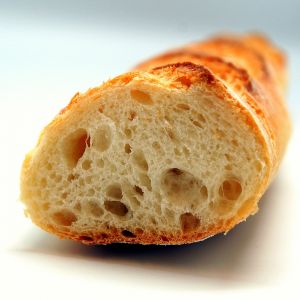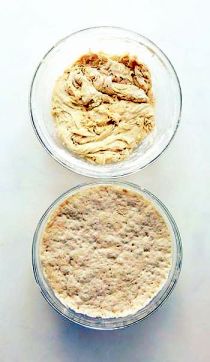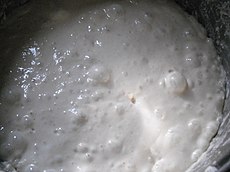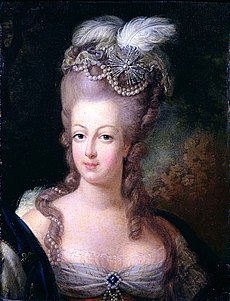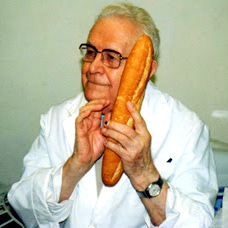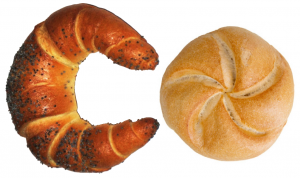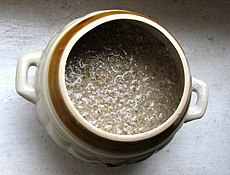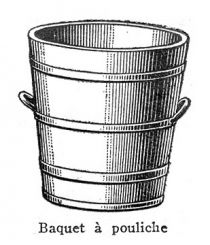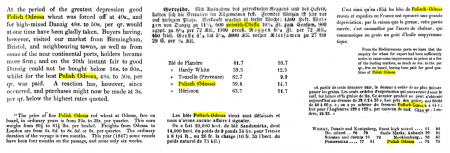Difference between revisions of "Is Poolish Polish?"
| Line 379: | Line 379: | ||
}} | }} | ||
| − | {{Nawigacja|poprz=Good Humour, Good Health: How They Do It in Asia}} | + | {{Nawigacja|poprz=Good Humour, Good Health: How They Do It in Asia|nast=Epic Cooking: The Decorous Rite of the Mushroom Hunt}} |
[[Category: Baguette]] | [[Category: Baguette]] | ||
Revision as of 10:31, 29 August 2021
If you ever happen to bake your own bread, then you may have heard of a yeast starter called poolish. And if you have heard of poolish, then you may have also heard that – as its name implies – it's a remarkable example of Polish contribution to the development of global baking. But is it? This is the question we're going to deal with today.
But for those who haven't heard of poolish, let's first explain what it is exactly. Poolish is a kind of highly-hydrated pre-ferment. Okay, if that didn't help, then let's start from the beginning.
Grain, Yeast, Beer and Bread
Ever since people domesticated cereals (or maybe it was the other way around), they have known that if you grind the grains down into flour, then mix the flour with water into dough and bake it, then you'll get a flat, brittle bread like roti, pita or matzo. But if you leave the dough in a warm place for a few hours before baking it, then it will start to bubble and rise; and if you then bake it, the bread will be soft, fluffy, pleasantly tart and aromatic. Beer, another cereal product, has been known about as long as bread. And it's been also known for a long time that if you gather the froth from the surface of fermenting wort and add it to the bread dough, then it will rise faster.
Centuries later, once microscopes were around, the bubbles that cause the dough to rise were shown to be produced by microörganisms. Oversimplifying, there are two kinds of them. One kind is lactic-acid bacteria, which eat the sugars present in the flour, excreting carbon dioxide and lactic acid. Bacteria like these are also responsible for milk going sour (hence their name: "lactic" means "milk", "acid" means "sour") and for cabbage turning into sauerkraut. In bread, pockets of the carbon dioxide are trapped in the dough, making the crumb porous and fluffy, while the lactic acid gives the bread its specific tart flavour. And yes, the dough which is left for bacteria to make it sour is called sourdough.
The other kind is a bunch of single-celled fungi found in the froth from beer wort and called yeast. Yeast cells eat sugar, excreting carbon dioxide and ethyl alcohol. They are also responsible for producing wine, mead and vodka. In bread, the carbon dioxide makes the bread fluffy, while the alcohol mostly evaporates during baking (which means you can't get drunk on bread; tough luck). Bakers, as we've already seen, used to obtain their yeast from breweries and add it to the starter for their dough (not sour at all).
The year 1842 saw the brewing of the world's first lager in Pilsen (now Plzeň, Czech Republic). Lager is a lower-fermentation beer, which means that the yeast, once done, sinks to the bottom of the vat rather than float to the surface. Pilsner-type lager caught Europe by the storm, which had the unexpected side-effect of bakers no longer having access to a source of fresh yeast, as there was nothing to collect from the surface of the lager brew. And fresh yeast was indispensable. In the case of sourdough, it's common to leave some of it to kick-start the next batch, with the resulting flavour only getting better every time. This approach doesn't work with yeast, though, as old yeast gives bread a rather unpleasant, stale aroma.
A method, therefore, was needed to somehow rejuvenate this old yeast. And this is why pre-ferments were invented. The idea is to effect preliminary fermentation and let new generations of yeast cells to bud out from the old ones. Only then comes the second phase of fermentation whose purpose is to rise the dough with the young population of yeast. Pre-ferments come in several kinds, such as the Italian biga (used in production of ciabattas) or the English sponge (used in making hamburger buns). But what we're interested in is the highly-hydrated pre-ferment, in which flour and water are mixed in equal proportion by weight, producing a loose starter similar in its consistency to pancake batter. This method is mostly used in preparing the dough for baguettes and other typically French rolls. And this is the method which is known by the word "poolish". Phew!
Let Them Eat… What Exactly?
Now that we know what poolish is, let's see how the French have learned to make it. We can start by looking at what can be gleaned from the Internet. Here's what one French culinary website has to say on the topic:
| Originally, poolish was invented to economise on industrially-produced yeast, which was expensive at the time when it was new on the market. Today this is no longer the case and the method is employed for its other advantages. This practice originated in Poland and it was Viennese bakers who introduced it in France for Marie Antoinette. | ||||
— Pain Poolish ou Pouliche, in: La cuisine de Fabrou, own translation
Original text:
|
Seems legit, doesn't it? After all, Marie Antoinette, an Austrian-born queen of France, is famous for her expertise in baked goods and for her piece of advice that those who can't afford bread should eat cake instead. Right? Well, not really, as it turns out. Firstly, the way this quotation is commonly rendered into English is quite loose, because what Marie Antoinette actually talked about was not cake, but brioche ("qu’ils mangent de la brioche"), a sweet bun made from dough rich in eggs and butter. The cake version must have spread in the English language before the brioche became popular in the English-speaking world.
And secondly… Marie Antoinette never really said anything like that. This sentence was originally attributed to an unspecified princess by Jean-Jacques Rousseau in an anecdote of his device. Back then, Marie Antoinette was ten years old and not even thinking about moving to France. It was only long after her death that the gibe was taken from the anonymous princess's mouth and put into the French queen's – most likely to provide some justification for why she'd been guillotined. Interestingly, in Samuel William Orson's translation of Rousseau's Confessions it's neither brioche nor cake, but pastry!
| I furnished myself from time to time with a few bottles to drink in my own apartment; but unluckily, I could never drink without eating; the difficulty lay therefore, in procuring bread. […] I could not bear to purchase it myself; how could a fine gentleman, with a sword at his side, enter a baker’s shop to buy a small loaf of bread? it was utterly impossible. At length I recollected the thoughtless saying of a great princess, who, on being informed that the country people had no bread, replied, “Then let them eat pastry!” | ||||||
— Jean-Jacques Rousseau: The Confessions of Jean Jacques Rousseau, transl. Samuel William Orson, Book VI, Project Gutenberg
Original text:
|
But let's get back to the poolish. Suppose this method really was developed to economise on mass-produced pressed yeast. It's hard to figure out, then, how it could have been done about a hundred years before such yeast actually hit the market. I suggest we no longer bother our heads about a headless queen and look for more reliable sources instead. Let's see, for example, what Bakerpedia, an online baking encyclopedia, has to say about the origin of poolish:
| This breadmaking method was first developed in Poland during the 1840s by a nobleman named Baron Zang. Poolish was later spread by Viennese bakers into Austria who upon emigrating to France around 1840 initiated the production of Vienna breads and other luxury bakery products in Paris using the Poolish technique. With this technique bakers switched from using associations of yeast and sourdough […] to yeast alone for carrying out fermentation at the bakeshop. |
| — Poolish, in: Bakerpedia |
So it wasn't an Austrian princess who helped introduce poolish to France when she arrived there in 1770; it was a nobleman who came to France from Austria 70 years later! But the crucial bit that both sources agree on is that poolish is a Polish invention. That's hardly surprising, as Poland is famous for its bread. It's more famous for its rye sourdough loaves than for yeast-raised wheat baguettes, though, but we wouldn't want to question this great Polish achievement and yet another source of Polish national pride, would we?
Well, of course we would! And so, by tracing the ultimate source of the information that eventually found its way to Bakerpedia and many other texts (print and online), we can determine that it relies on the authority of Raymond Calvel, the professor of baking at the National Higher School of Milling and Cereal Industries (ENSMIC) in Paris who wrote the book on baking bread. This is what the book, The Taste of Bread, says about where the poolish method comes from:
| This method of breadmaking was first developed in Poland during the 1840s, from whence its name. It was then used in Vienna by Viennese bakers, and it was during this same period that it became known in France. The bread produced by this method became known as Vienna bread, named for those Austrian bakers who began to make it in Paris after having come from Vienna. The poolish method seems to have become the only breadmaking method used in France until the 1920s for production of breads leavened solely with yeast. […] The Vienna bread made during that period was the result of a production method introduced into France by an Austrian, Baron Zang. With the assistance of a group of Viennese bakers, the Baron began to produce this type of bread in Paris in 1840, in a bakery that still exists today on the Rue de Richelieu. This bread corresponded to our definition of “traditional” bread, since it was made from a mixture of flour, water, yeast and salt, occasionally enriched with the addition of a little malt extract. It was leavened with a poolish, and was thus a baker's yeast leavened product. During the whole of the 1840s–1920s, this type of bread experienced well-deserved commercial success in the larger French cities, especially Paris. As may be seen still today on the advertising signs of old bakeries, the consumer had the choice between “French bread” made from levain [i.e., sourdough starter], and Vienna-style bread, made from baker's yeast. | ||||||
— Raymond Calvel: The Taste of Bread, transl. Ronald L. Wirtz, ed. James J. MacGuire, Springer Science+Business Media, 2001, p. 42, 116
Original text:
|
If a bread-making expert of this stature said that poolish was of Polish origin, then few people saw the reason to question this assertion. Well, alright, but who was this supposedly Polish baron with a rather non-Polish-sounding name, credited with bringing from Austria to France the pre-ferment which gave rise to French baguettes?
The Baker in Spite of Himself
According to Jim Chevalier, a specialist in French bread history, Christopher August Zang was born in 1807 in the family of a Viennese surgeon. As a young man, Zang served as an artillery officer and studied chemical engineering in the Austrian capital. When he was 28, his military career was cut short by his father's death. After all, why pursue a career of any kind, if you've inherited a fortune from your dad? The inheritance was enough for some time of carefree indulgence and then, all of a sudden, it ran dry. Zang managed a soft landing by marrying into a rich family, but this experience taught him that once you earn some funds, it's better to invest them rather than blow them all on consumption. And so Zang discovered in himself a knack for entrepreneurship.
As a keen observer, Zang noticed visiting French people raving about Viennese bread. Whenever he was in Paris, he could see for himself that French bread – dark, heavy and sour – was nothing like what was available back in Vienna. There was an obvious niche on the French baking market and Zang resolved to enter this niche with a little capital. In 1837 he moved to Paris, where he and his business partner, Ernest Schwarzer, opened a new bakery at 92, rue de Richelieu. Do you need to know anything about baking bread to run a successful bakery? Not necessarily, as Zang and Schwarzer promptly demonstrated; all you need is to hire good Viennese bakers, trust that they know what they're doing and have the guts to invest in the technological innovations these bakers recommend. In the meantime, the owners focused on marketing; after all, if you're investing in technological novelties, your customers should be made aware of that. And so, Zang's patrons (Schwarzer sold his share to Zang in 1839) soon learned that the dough for Zang's bread was kneaded not by a sweaty half-naked baker, but by a modern, hygienic machine, and that the loaves were baked in a special steam oven which gave the finished product an appetisingly shiny crust. Parisians were quick to learn about the advantages of "Viennese" baked goods, which owed their highly-prised aroma, lightness, whiteness and freshness to a combination of good Hungarian wheat flour and baker's yeast (free from the hoppy bitterness of brewer's yeast).
Zang's establishment was known as Boulangerie Viennoise, or "Viennese Bakery". True to its name, it offered Austrian breadstuffs that had been hitherto unknown in Paris, such as Kipferl, or Viennese crescent rolls (dubbed "croissants" by the French), and Kaisersemmel, or kaiser rolls (which Parisians referred to simply as "petits pains viennois", or "little Viennese breads"). Zang's commercial success was quickly copied by local bakers, so that by 1840 a dozen shops offering "Viennese" breads had sprung up across Paris.
Eight years later a wave of revolutions known as the Springtime of Nations swept across Europe, upsetting the order which had been established in the wake of Napoleonic wars. France became a republic again, while political reforms in Austria brought about a greater freedom of the press. For Zang this was an occasion to invest in a completely new business. He sold the bakery and returned to Vienna, where he became a newspaper publisher. Here, again, he would bet on innovation; his paper Die Presse published short paragraphs arranged in columns, novels in episodes and numerous advertisements which helped maintain a competitive price. Zang stayed in this business for two decades until he sold his publishing house only to move on to banking and mining (the lignite mine that he purchased in Styria bears the name Zangtal to this day).
Zang was without a doubt an affluent and influential man, but he could only be described as a baron in the figurative sense. He never bore any actual titles of nobility, whether by birth or by grant. Was he proud of his contribution to the development of French bread-making? Not particularly. In fact, he actively tried to hide this episode of his professional life, spurred on by his business and political rivals dismissing him as a simple baker. Contrary to his efforts, however, his name had become a strong enough brand on the French bread market that subsequent owners of the bakery at 92, rue de Richelieu, consistently refused to remove it from the shop sign, even when offered financial compensation. Zang's name was still prominently displayed on the bakery's façade long after his death in 1888.
All the while, Viennese bread in France kept evolving. By the early 20th century, the word "viennoiserie" (literally, "Viennese stuff") had been coined in French in the sense of "luxury Viennese-type breads". But at the same time, these "Viennese" breads were becoming increasingly more French than Austrian. Supposedly Viennese croissants were now made with French puff pastry rather than traditional yeast dough. The latter did survive, however, in a new kind of bread rolls which only became common in the 1920s. These rolls were long and thin, white and sweetish (which made them attractive to consumers), but were very quick to go stale, so you had to buy them 2–3 times a day (which made them attractive to bakery owners). Due to their distinctive baton-like shape, they became known as "baguettes", or "little sticks". And this is how French baking as we know it today came to be. By that time, poolish had been in common use in France, especially for the production of baguettes. But this was already long after Zang's death and even longer after he had divested himself of his Parisian bakery. Which means it probably isn't him who should get the credit for introducing poolish to France.
TL;DR: It's true that Zang opened in Paris a bakery, in which he employed Viennese bakers, but he was neither a baker himself nor a baron, nor Polish. And it wasn't him who brought poolish to France. But if not him, then who? And is there any connection between poolish and Polish bakers after all?
What's in a Name?

| “Poolish” comes from an English word which means “Polish” and refers to a French bread-making method imported by the Austrians. Four countries to define one method! | ||||
— Marc Dewalque: La pouliche ou poolish, histoire, in: BoulangerieNet, 3 October 2007, own translation
Original text:
|
We know by now that while Prof. Calvel was a great authority on baking bread, he was not infallible, especially in matters of history. Besides, it seems he must have repeated the story about "Baron" Zang "from Poland" after someone else, as the same information had already appeared in The Atlantic Monthly in 1972.[1] Is it possible, then, that he was wrong not only about Zang being Polish, but also about the Polish origin of the poolish method? Let's take a closer look at the word itself: the spelling looks neither Polish nor German, nor French. If it looks like anything, it's English – but weird English, like the word "Polish", but written with a double "O" for whatever reason.
I've examined a variety of ancient sources while looking for a possible etymology of the word "poolish", from 19th-century grain exchange reports to early-21st-century online message boards for bakers. It turns out there's a number of hypotheses, none of them convincing.
Poolish ← Polish
The explanation which is most common (thanks to uncritical repetition) links "poolish" with the English word "Polish". Some sources say that "Poolish" is an old alternative spelling of the same adjective, but I haven't been able to find a dictionary that would confirm that. Yet, even if it were true, it only helps muddle the matter more than to elucidate it; why would the French call a Polish method they learned from the Austrians by an archaic English word? You can sense the frustration with how little sense it all makes in this post by Mr Thierry Martin in the French baking forum BoulangerieNet:
| But the word itself? Why the heck an English one? And an old English one at that? And only used in France, as it's used neither in Poland nor in Austria, nor in England! | ||||
— Thierry Martin: La poolish est-elle polonaise ?, in: BoulangerieNet, 21 February 2010, own translation
Original text:
|
The same user (a dentist and home baker from the island of Reunion) later comes to the logical conclusion that even though Polish people are known for making good bread, it's not enough to prove a Polish origin of the poolish method.
Poolish ← Polisch
Some of the oldest French-language mentions of this supposedly Polish starter use the spellings "poolisch" or "polisch" (with "sch"), which suggests an alternative version of the above etymology. Namely, that the word comes not from English, but from German. But isn't the German word for "Polish" written as "polnisch", with an "N"? Yes, it is in modern Standard German; but in 19th-century southern dialects (used in Austria), the same adjective could be written without the "N", as "polisch", "pohlisch" or "pollisch". And some of these spellings can be found in the context of bread starters. For example, an 1865 advertisement for St. Marxer, a Viennese brand of pressed yeast, mentions a "Polisch" method. The word, in this sense, seems to have been largely forgotten in German with time, but even a century later a German bread-making handbook still talked about a "polische" bread dough:
| The polische dough, with its minimal yeast requirement, was […] the standard way of preparing Viennese white bread at the time. The use of very long working time was made possible by the practically unlimited working hours in the era of manual labour. One was choosing here a lesser evil: it was better, by using a polische starter, to accept a somewhat rough texture with unpredictable crumb pores and weak colouration of the baked product than to lower its quality by using more brewer's yeast. | ||||
— Brot und Gebäck, vol. 19–21, Arbeitsgemeinschaft Getreideforschung, 1965, p. 151, own translation
Original text:
|
But this is still no proof for the method having been developed in Poland. Dr. Matthew Baerman, in his article for the linguistic blog Morph, suggests that the name may have come from a mental association made between the loose starter and the famous Polish fermented-rye-meal soup called "żur" (pronounced zhoor) or "żurek" (ZHOO-reck) – even though the soup is made from diluted sourdough rather than a yeast starter.[2] In fact, some German sources use the name "polnische Suppe" ("Polish soup") for the loose yeast pre-ferment.[3] What Dr. Baerman may have been unaware of is that the word "żurek" also has a special meaning in Polish baking terminology, where it refers to a loose sourdough starter. But this is a kind of starter Polish bakers use for making chleb (pronounced h'lep), a sourdough rye bread, rather than for white yeast rolls. Mixed rye-wheat chleb is also common in Poland, but even then you would prepare a rye sourdough starter and a wheat yeast pre-ferment separately.[4][5]
Whatever the case, Dr. Baerman admits that "this theory has the minor drawback of lacking any positive evidence in its favor."
Poolish ← Pouliche
But there's still more confusion to come. Some of the oldest texts about poolish use a different, much more French-looking, spelling: "pouliche". And it's not only French-language sources that do it; "pouliche" appears for example in an article about French bakeries which was published in an American millers' magazine in 1897,[6] as well as in an American handbook written by an Austrian baker in 1903.[7]
The trouble is that in French the word "pouliche" has a meaning which is completely unrelated to baking; it means "filly". What could a young female horse have to do with a yeast starter? Perhaps someone associated a pre-ferment, whose purpose is to rejuvenate a yeast population, with a young equine? Or maybe fermenting and bubbling dough reminded someone of a prancing filly? We can only guess. In any case, this the etymology that Jim Chevalier is leaning to. In his opinion, the pseudo-English phonetic spelling "poolish" appeared after the original "pouliche", and it was only then that its similarity to the English word "Polish" gave rise to the story about the method's Polish origin. And to make this story more believable, someone decided to explain the Polish-French connection by adding the famous August Zang as a missing link.
Poolish ← פאליש
I've found an even more surprising hypothesis, which proposes that the work "poolish" comes from "polish" (פאליש), which is a Yiddish word for a synagogue antechamber. The idea here is that a pre-ferment is the first step towards a finished bread, just like the antechamber is the first step towards the synagogue. In the central (Polish-Galician) dialect of Yiddish, the vowel "o" is closer to the "oo" sound, which would explain the "poolish" spelling in English transcription, as well as indicate a Polish origin of the method. Except that, in this case, the authorship of this method would belong not to Poles in general, but specifically to Polish Jews.
Prof. David Gold, who suggested this possibility, admits that it "sounds farfetched".[8]
Or Maybe It's Poolish ← Polish After All?
When looking for the oldest possible anchor points, I discovered that west European press, starting in the first half of the 19th century, often used the phrase "Polish Odessa" (also spelled "Polisch Odessa"), which is quite surprising when you consider that Odessa was never a Polish city. It turns out, however, that this was the name used for the wheat imported from what is now western Ukraine.
This is how Polish wheat varieties were described in a French book on grain trade from 1910:
| The wheat from Poland is exported via Danzig and Odessa; it is often confused with Russian wheat and known as “Odessa wheat” if exported through that port. It comes in white, yellow and red varieties; whether pure or mixed, the most appreciated types come from Sandomierz and Cracow. […]
The kinds [of wheat from Russia] most commonly used include the high-quality Polish red. It is called “nervous”, which means it helps the dough rise […] | ||||
— Paul van Hissenhoven: Les grains et le marché d'Anvers, Anvers: Imprimerie Aug. van Nylen, 1910, p. 24, own translation
Original text:
|
Throughout the 19th century, the wheat which grew in the Russian-controlled territories of the erstwhile Polish Commonwealth was exported to the west via two routes. The northern route went from the Sandomierz area in what is now southeastern Poland down the Vistula river across the Prussian partition of Poland to Danzig (now Gdańsk) and from there, on Dutch merchant ships, across the Baltic and North seas to London. The southern route took the grain from the regions of Volhynia and Podolia (now western Ukraine) down the Dniester river to Odessa and thence, on Greek ships, across the Black and Mediterranean seas to London. At the time, London was Europe's chief grain-trading hub; it was on London exchanges that people speculated on grain before it had even reached the shores of England, settled its price and decided which batch of wheat would eventually go to which port in western Europe.[9]
No wonder that even in France the wheat from Poland was known under the English trade name of "Polish". But the French have always been very creative in butchering the words they loaned from English (mind you, the French word for "shampoo" is "shampooing" and the French for "walkie-talkie" is "talkie-walkie"), so it shouldn't come as a surprise that they would write the English word "Polish" as "Polisch" or even "Poolish".
And now it's time for my own proposition: the poolish method was developed in France, but it gave the best results with the "nervous" Polish wheat, which was known in France as "Poolish" (among other misspellings) and lent its name to the method. Only once the name "poolish" had caught on, along with the pseudo-English pronunciation to match the butchered spelling, was the French phonetic spelling "pouliche" (which also happens to be the French word for "filly") coined.
Is this proposition supported by any historical sources? No. Is it far-fetched? Definitely. But is it more of a stretch than the other etymologies presented above? I shall leave it for the Reader to decide. So what do we know for sure? That poolish was invented in France rather than in Poland, and in the second half of the 19th century, so it couldn't have been popularised by August Zang – let alone by Marie Antoinette's court bakers. But the origin of its name will remain a mystery.
References
- ↑ Betty Suyker: A la Recherche du Pain Perdu, in: The Atlantic Monthly, Boston: July 1972, p. 90–92; quoted in: Matthew Baerman: Poolish, in: Morph: A Blog About Languages And How They Change, 24 April 2019; also quoted in: Mae Travels: Baker's Words, in: Mae's Food Blog, 14 February 2018
- ↑ Matthew Baerman: Poolish, in: Morph: A blog about languages and how they change, 24 April 2019
- ↑ Martin Seiffert: Technik der Weizenvor- und Sauerteig-Führungen in Deutschland und Europa, in: Handbuch Sauerteig, ed. Markus J. Brandt, Michael Gänzle, Behr's Verlag, 2006, p. 286
- ↑ Piekarstwo: receptury, normy, porady i przepisy prawne, ed. Mieczysława Janik, Warszawa: Zakład Badawczy Przemysłu Piekarskiego, Handlowo-Usługowa Spółdzielnia „Samopomoc Chłopska”, 2002, p. 11–12
- ↑ Technologia żywności: podręcznik dla technikum, ed. Mieczysław Dłużewski, part 4, Warszawa: Wydawnictwa Szkolne i Pedagogiczne, 2008, p. 23
- ↑ W.S. Harwood: The Bread of Paris, in: The Northwestern Miller, v. 44, Minneapolis: Miller Publishing Company, October–December 1897, p. 31
- ↑ Emil Braun: Baker's Book: A Practical Hand Book of All the Baking Industries in All Countries, vol. 2, New York: Van Nostrand, 1903, p. 317; quoted in: Jim Chevallier: Before the Baguette: The History of French Bread, North Hollywood: Chez Jim, 2019
- ↑ David L. Gold: Studies in Etymology and Etiology: With Emphasis on Germanic, Jewish, Romance and Slavic Languages, Universidad de Alicante, 2009, p. 584–585
- ↑ Morton Rothstein: Centralizing Firms and Spreading Markets: The World of International Grain Traders, 1846–1914, in: Business and Economic History, Second Series, vol. 17, Business History Conference, 1988, p. 103–113
Bibliography
- Raymond Calvel: Le Goût du Pain : Comment le préserver, comment le retrouver, Éditions Jérôme Villette, 1990
- Jim Chevallier: August Zang and the French Croissant: How Viennoiserie Came to France, North Hollywood: Chez Jim, 2009
- Jim Chevallier: Before the Baguette: The History of French Bread, North Hollywood: Chez Jim, 2019
- Henryk Piesiewicz: Podmłody – ważny element procesu produkcji, in: Przegląd Piekarski i Cukierniczy, Warszawa: Wydawnictwo Czasopism i Książek Technicznych SIGMA-NOT, May 2013, p. 28–30
- Henryk Piesiewicz: Powrót do tradycyjnych rozczynów: Podmłody, in: Przegląd Piekarski i Cukierniczy, Warszawa: Wydawnictwo Czasopism i Książek Technicznych SIGMA-NOT, December 2013, p. 20–22
| ◀️ Previous | 📜 List of posts | Next ▶️ |
| ⏮️ First | 🎲 Random post | Latest ⏭️ |
